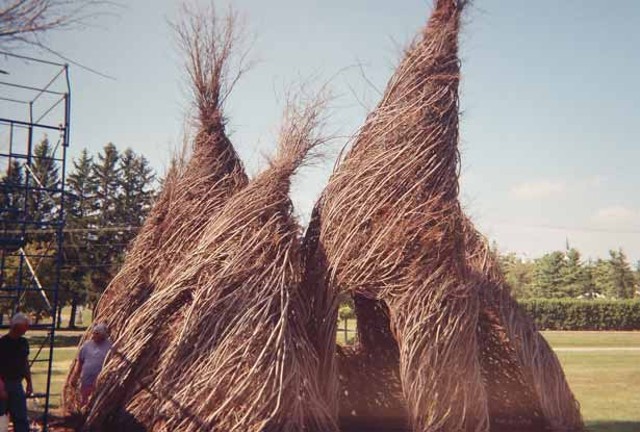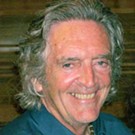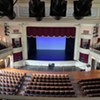Published September 26, 2007 at 9:13 p.m.
Patrick Dougherty gives multiple meanings to the term "public art." Not only do his sculptures reside in public spaces, but he builds them publicly and enlists community members in assembling his soaring, swirling, shaggy shapes. To Dougherty, demystifying the creative process may be as important as what he actually produces. With his method of art-making, the 62-year-old raconteur explained recently, "There are no studio doors to close, no places to hide."
For the past two weeks, students and residents of Middlebury have been watching Dougherty and helping him assemble a set of nine stick structures in front of the college arts center. Each twists to a height of about 15 feet, listing this way and that. With oval openings to their hollow interiors, the forms resemble tipsy teepees.
They also look a bit like Dougherty himself. His slim frame stretches nearly 6 and a half feet, crowned with a white mane that isn't so much combed as clumped.
The still-untitled Middlebury installation, scheduled for completion on September 28, plays off what Dougherty sees as "the peaks and valleys" of the arts center's roof-line.
His structures have a slightly goofy quality that somehow doesn't diminish their dignity. Dougherty has used local materials in most of the nearly 200 commissioned works he's completed in venues as varied as a sketchy suburb of Dublin and the lobby of One World Trade Center. The Middlebury composition consists entirely of interwoven silver maple and dogwood saplings.
"Sticks have an inherent tendency of joining," Dougherty explains in a faint drawl that stretches out the syllables in a word like in-her-ent. "Every stick has flexibility. And because they're tapered, they give a sense of flow and direction."
He came to this medium by chance. Heading to his home in North Carolina one day in 1980, Dougherty recalls, he was transfixed by tangles of saplings jutting from the brush beside his driveway. At the time, he was toiling through art-history books and enduring sculpture classes at the University of North Carolina in a quest for inspiration. "I was a kind of an art nerd," Dougherty says. "I'd go around looking at what students were making and I'd ask, 'Is this art? Is this art?'"
He's since achieved clarity on what art is - and isn't. He understands it as a participatory undertaking that culminates in a temporary display with populist appeal.
About 200 volunteers have taken part in Dougherty's Middlebury project. Some rip leaves off saplings piled near the piece; others wedge and bend the sticks into place as they clamber along the scaffolding surrounding the work-in-progress. Everyone taking part in the project is expected to sign a release clearing the college of responsibility for any injuries that might occur.
Most of the workers are students, but many attend schools other than Middlebury. Susan Raber has brought along 18 members of the class on natural materials and shelters she teaches at the University of Vermont. Local high school and elementary students have been drawn to the site, as well. One morning, a group of daycare toddlers helped trim twigs.
Dougherty has both the charisma and kindness of a master teacher, Raber observes. "He's very positive and mellow. He always makes the time to talk to students," she says.
The intended audience for Dougherty's collaborations doesn't consist of academics and unreconstructed art nerds. Instead, he's seeking to reach "the person walking by with his dog [or] the UPS guy," as he explained to The Philadelphia Inquirer in 2000.
And, just as the assemblages rise from the earth, so too will they return to it. A Dougherty work remains in place an average of two years before it's deemed too decrepit to retain its artistic integrity. The Middlebury installation - whatever Dougherty and his posse decide to call it - will continue to stand sentry outside the arts center until Vermont's climate dismantles it. The sticks will then be carted off and composted.
More By This Author
Speaking of...
-

Q&A: Catching Up With the Champlain Valley Quilt Guild
Apr 10, 2024 -

Video: The Champlain Valley Quilt Guild Prepares for Its Biennial Quilt Show
Apr 4, 2024 -

Middlebury: What to See, Do and Eat During the Eclipse
Mar 6, 2024 -

In Terms of Registering to Vote, Midd Kids Are Top of the Classes
Feb 28, 2024 -

Q&A: Meet a Family in Waterbury That Embraces Halloween Year-Round
Feb 14, 2024 - More »
Comments
Comments are closed.
From 2014-2020, Seven Days allowed readers to comment on all stories posted on our website. While we've appreciated the suggestions and insights, right now Seven Days is prioritizing our core mission — producing high-quality, responsible local journalism — over moderating online debates between readers.
To criticize, correct or praise our reporting, please send us a letter to the editor or send us a tip. We’ll check it out and report the results.
Online comments may return when we have better tech tools for managing them. Thanks for reading.















































